A Pocket Guide to Pavement
So you want to go on a bike tour.
Along the way you will no doubt cross through the beautiful, wild places of the U.S., from towering conifer forests to unfurling golden plains to colorful deserts. Charming towns and enormous cities will impress you and act as oases where you can rest and recharge. However, the main event of any bike tour is the edge of the road itself. There are over three million miles of two-lane highway in America and countless other boulevards, residential mazes, curvy country roads, and city streets.
The seemingly endless ribbon on the margins is the domain of the touring cyclist and constitutes the conveyor belt that will carry you from Point A to Point B. This guide is intended to aid both the novice and the connoisseur of surface in identifying and navigating the varied terrain of the U.S. road shoulder. Become well acquainted with these features of the road and every inch of your bike tour will hold more interest and excitement than ever before.
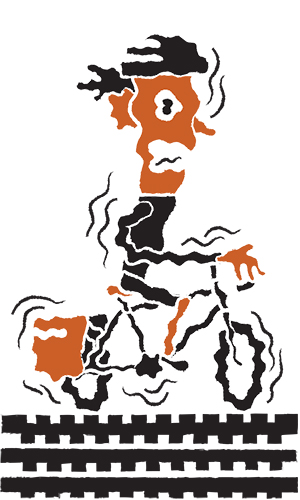
Erratic Rumble Strip
Common names: Rogue Rumble Strip, the Rumble Down Under
Description: A telltale sign of this feature is its unpredictability. First it’s on the left, then the right, then the middle, hogging most of the smooth shoulder and forcing you to ride whatever pavement is left over. And just when you think you have it figured out, there it comes veering from the left, sure enough rumbling you right out of your seat and your sanity. You can’t win against this foe — even the steadiest riders will inevitably find themselves slip just enough to end up on this concrete washboard, praying they tightened everything down good and firm on their racks.
Commonly occurs: The day after you lose your only pair of padded bike shorts down the river while washing them.
Common responses: Bafflement, confusion, resentment.
Navigation technique: Loudly disparage the hypothetical machine operator who must be responsible for this injustice.
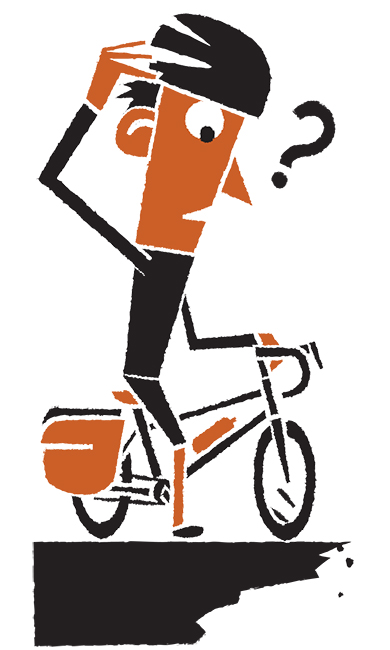
Shoulder/No Shoulder
Common names: The D.O.T. Magic Show, the Houdini Highway
Description: Heartbreaking and unpredictable, this shoulder type (or lack thereof) will have you trapped in a cycle of preparing for the worst and hoping for the best. Characterized by an abrupt and unexpected terminus, this specimen will leave you to fend for yourself. Just when you think you’re stuck straddling the white line to tuck away from a sudden onslaught of traffic, a wide and glorious strip of pavement appears. Don’t be fooled. It won’t last long.
Commonly occurs: On heavily trafficked roads during a headwind after exclaiming, “Wow! This shoulder is really nice.”
Common responses: Feeling of betrayal, hopelessness, cognitive dissonance.
Navigation technique: Keep telling yourself that things will be better around the next bend.
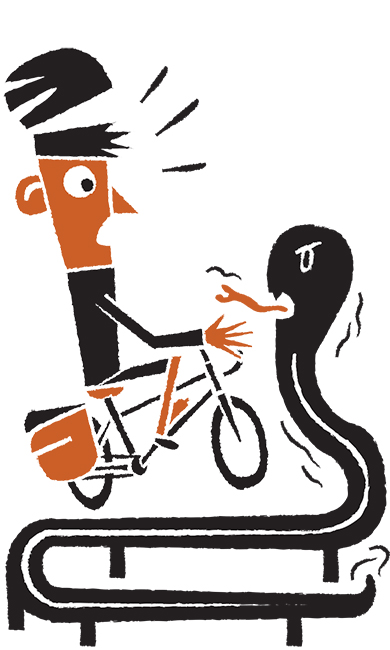
Guardrail
Common names: The Trash Compactor, Biker’s Blight
Description: What in a car is a reassuring safeguard becomes to the average cyclist a mortal enemy. This pesky devil will try to catch your pedals at every turn and belly-bump you into the next passing car. The pavement is fine and your legs are feeling fresh as you relax on a nice shoulder, and here comes this familiar nuisance, nosing in on your territory and leaving no room for escape. Ride too close to the rail and you may get hung up. Ride too close to traffic and other dangers await. (A common variation of the classic metal guardrail is the concrete jersey barrier, an even more stubborn and intimidating obstacle.)
Commonly occurs: An hour after realizing the all-you-can-eat buffet was not the brilliant idea it seemed at the time.
Common Responses: Dismay, fear, nausea.
Navigation Technique: Don’t look down.
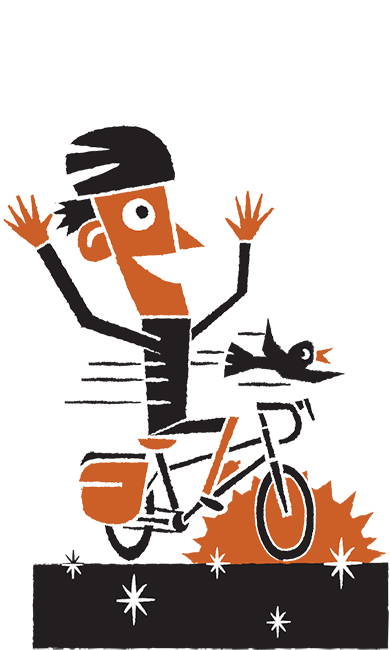
Blacktop
Common names: Tennessee Tarmac, the Velvet Highway
Description: Sometimes it steams on a cold morning. Sometimes the molasses nuggets of asphalt gleam in the afternoon sun. Shhhh, what’s that sound? You’re flying down the road, but not a peep can be heard, not a rattle can be felt. Rare and downright extinct in some states, a freshly paved asphalt road will make you think a bike tour was the best idea you ever had. The fresher, the better — the birds will sing and your legs will feel like two well-oiled pistons. Some such roads have yet to be striped, giving the impression of one luxurious megashoulder. This is as good as it gets, folks.
Commonly occurs: When the rain that has been constantly pouring for three days lets up and just after passing through a cloud of stench from an unrecognizable bit of roadkill.
Common responses: Euphoria, zero-gravity tingle, love.
Navigation technique: Savor every last inch.
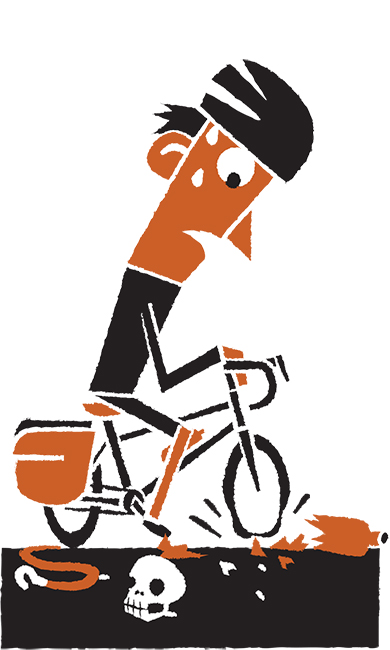
Double Wide
Common names: Cluttered Carriageway, Asphalt Flea Market
Description: As messy as it is wide, this shoulder type will keep you on the edge of your seat. At first glance, it seems you could curlicue your way down the shoulder with all the space you have. Look again and you’ll see a wave of litter has washed up at the pavement’s edge. If you have the energy, play around in this amusement park by steering through the shattered glass and broken TVs, trying to nudge plastic bottles out of your way. The potential for flat tires is high in these areas, as is the potential for a sweet find. Need a new bungee or bandana to spice up your tired wardrobe? Look no further. Just hope someone didn’t also chuck a box of thumbtacks out his window.
Commonly occurs: As ash is falling through the sky from a nearby forest fire.
Common responses: Temptation, swerving, swivel neck.
Navigation techniques: Remind yourself that anything you pick up will add that much more weight to your already sluggish steed.
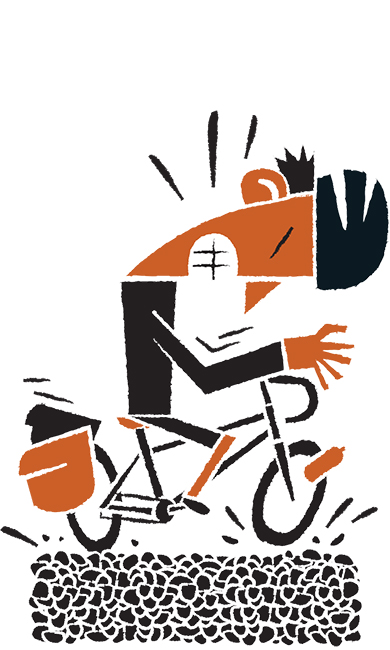
Chip Seal
Common names: The Sandpaper Circuit, Classic Contact
Description: It’s loud, it’s rough, it’s unforgiving, and it’s a classic and widespread type of pavement. The harsh finish is the telltale sign for this one. It is often accompanied by a smattering of potholes and regular bumps. It’s not uncommon to ride along an edge that is crumbling away into the ditch or gravel swath on the side of the road. Other signs of deterioration such as crocodile cracking, rutting, and frost heaves are commonplace. You will get up close and personal with every little bit of aggregate jutting just far enough above the surface to produce a constant vibration. Settle in and accept the buzz, knowing the increased friction on your tires will slow you down and require you to exert that much more energy on every pedal stroke. Every passing car will also tear up your eardrums going over this ragged road.
Commonly occurs: During a thunderstorm as it dawns on you that the saddle you chose for your trip is not as comfortable after Mile 2,300.
Common responses: Instant fatigue, white knuckle, acceptance.
Navigation technique: Count the days you have left, tell yourself it doesn’t sound so long, and then quickly retreat to your happy place.
This essay originally appeared in the March 2018 issue of Adventure Cyclist magazine.


